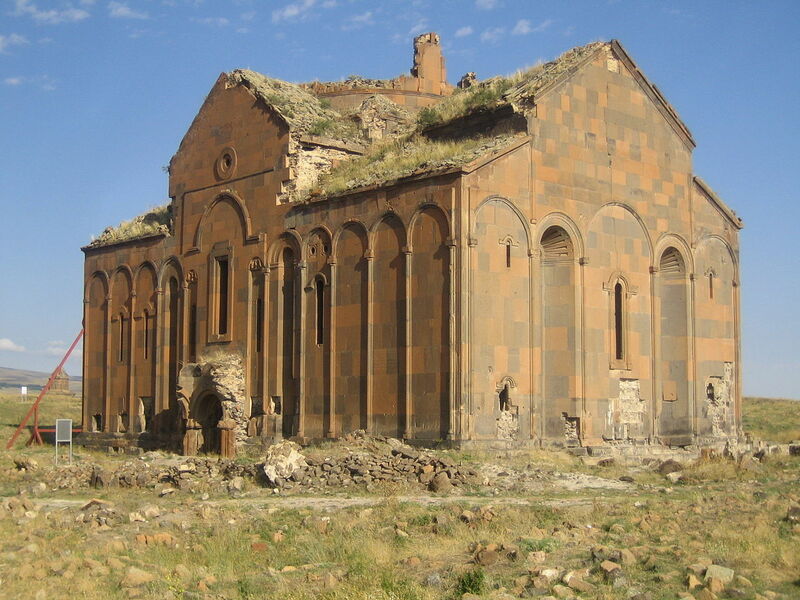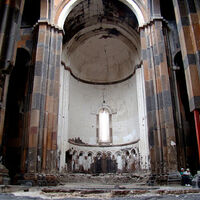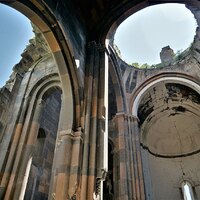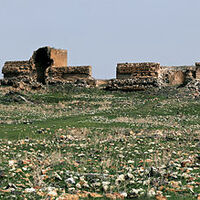Ani Cathedral
Type:
Churches,
Cities,
Wall paintings
Date:
1001
Location or Findspot (Modern-Day Country):
Turkey
Description:
Ani, now at the eastern border of Turkey, was the capital of the Armenian kingdom ruled by the Bagratid dynasty between 961 (when the capital moved there from Kars) and 1045, when the city was conquered by the Byzantines. The walled city controlled a branch of the Silk Routes into Asia Minor, and its population exceeded 100,000. The site declined in importance after the Mongol invasion and an earthquake in 1319, and it was abandoned after another earthquake in the early seventeenth century. Nevertheless, over twenty ancient and medieval structures are preserved.
The Bagratids' chief architect, Trdat, designed the cathedral at the center of the city and was also called to Constantinople to rebuild the dome of Hagia Sophia after its partial collapse in 989. Ani's cathedral is constructed of rubble masonry revetted with dark the same dark red stone as the much earlier church at Mren, 34 kilometers to the south. Like Mren, the cathedral at Ani is a domed basilica (approximately 35 × 22 m). The drum and pendentive dome, supported by tall pointed arches that spring from compound piers, have collapsed. The exterior, enlivened by blind arcades, features numerous Armenian inscriptions. The longest, a twenty-one-line text on the south facade, says that the church was founded by King Smbat II in 989 and finished by his sister-in-law, Queen Katranide, in 1001. The same text also names Sargis, the catholicos (patriarch) of the Armenian church, and Bene, the scribe. Shorter exterior inscriptions record donations to the cathedral and the city, including one (ca. 1060) about taxes on traders in Ani. On the interior, the whitewashed central apse contains a scene of Christ enthroned between angels and evangelist symbols.
The Bagratids' chief architect, Trdat, designed the cathedral at the center of the city and was also called to Constantinople to rebuild the dome of Hagia Sophia after its partial collapse in 989. Ani's cathedral is constructed of rubble masonry revetted with dark the same dark red stone as the much earlier church at Mren, 34 kilometers to the south. Like Mren, the cathedral at Ani is a domed basilica (approximately 35 × 22 m). The drum and pendentive dome, supported by tall pointed arches that spring from compound piers, have collapsed. The exterior, enlivened by blind arcades, features numerous Armenian inscriptions. The longest, a twenty-one-line text on the south facade, says that the church was founded by King Smbat II in 989 and finished by his sister-in-law, Queen Katranide, in 1001. The same text also names Sargis, the catholicos (patriarch) of the Armenian church, and Bene, the scribe. Shorter exterior inscriptions record donations to the cathedral and the city, including one (ca. 1060) about taxes on traders in Ani. On the interior, the whitewashed central apse contains a scene of Christ enthroned between angels and evangelist symbols.
Relevant Textbook Chapter(s):
6
Repository and Online Resources:
• Ani is a UNESCO World Heritage site.
• Read more about the cathedral and other structures at Ani at VirtualANI.
• See excellent photographs of Ani in an article in The Atlantic, 24 January 2014.
Image Credits:
Wikimedia Commons




